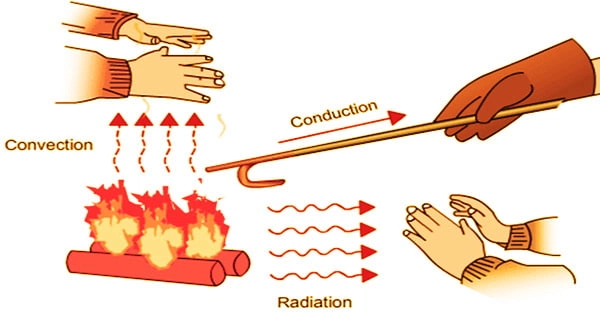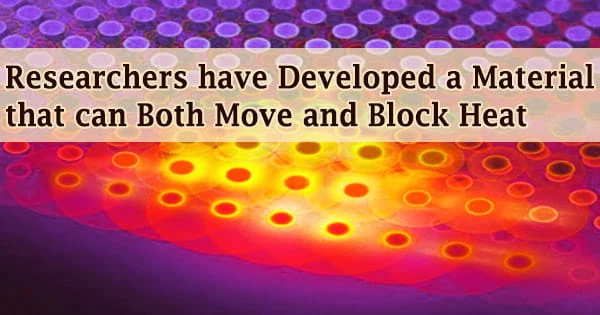One of the major problems of engineering is transporting heat around where you want it to go, such as in houses and hair dryers, or removing it from automobile engines and freezers. Because energy disappears from everything we do, every action creates heat. However, excessive use can deplete batteries and electrical components, such as those in an outdated laptop that is too hot to rest on your lap. You have a problem if you can’t get rid of heat.
A thermal insulator manufactured using innovative technology has been devised by scientists at the University of Chicago as a novel way to route heat around at the tiny level. They build a material with atoms aligned in one direction but not the other by stacking ultra-thin layers of crystalline sheets on top of one other and rotating each layer slightly.
The combination of excellent heat conductivity in one direction and excellent insulation in the other direction does not exist at all in nature.
Jiwoong Park

“Think of a partly-finished Rubik’s cube, with layers all rotated in random directions,” said Shi En Kim, a graduate student with the Pritzker School of Molecular Engineering who is the first author of the study.
“What that means is that within each layer of the crystal, we still have an ordered lattice of atoms, but if you move to the neighboring layer, you have no idea where the next atoms will be relative to the previous layer the atoms are completely messy along this direction.”
The result is a material that is excellent at both containing and transporting heat, although in separate directions, a unique characteristic at the microscale, and one that might be valuable in electronics and other technology.
“The combination of excellent heat conductivity in one direction and excellent insulation in the other direction does not exist at all in nature,” said study lead author Jiwoong Park, professor of chemistry and molecular engineering at the University of Chicago. “We hope this could open up an entirely new direction for making novel materials.”
“Just amazingly low”
Scientists are always looking for materials with unexpected characteristics because they can open whole new capabilities for electronics, sensors, medical technologies, and solar cells. The discovery of a weird substance that can flawlessly conduct electricity, for example, enabled the development of MRI machines.
Park’s team had been looking at ways to create ultra-thin layers of materials that were only a few atoms thick. Typically, device materials are built up of exceedingly regular, repeating lattices of atoms, making it very simple for electricity (and heat) to pass through them.
However, the researchers pondered what would happen if they piled each succeeding layer while rotating it slightly. They analyzed the data and discovered that a tiny wall built of this substance was particularly effective in stopping heat transfer between compartments.
“The thermal conductivity is just amazingly low as low as air, which is still one of the best insulators we know,” said Park. “That in itself is surprising because it’s very unusual to find that property in a material that is a dense solid those tend to be good heat conductors.”
The scientists were most excited when they assessed the material’s capacity to transmit heat along the wall and discovered that it could do so quite effortlessly.
These two characteristics, when combined, might be quite beneficial. Making computer chips smaller and smaller, for example, results in more and more power flowing through a tiny region, producing a hazardous hotspot with a high “power density,” according to Kim.
“You’re basically baking your electronic devices at power levels as if you are putting them in a microwave oven,” she said. “Because some electronics components are particularly unstable at high temperatures, one of the most difficult tasks in electronics is to deal with the heat at that scale.”
“But if we can use a material that can both conduct heat and insulate heat at the same time in different directions, we can siphon heat away from the heat source such as the battery while avoiding the more fragile parts of the device.”
This capacity may allow engineers to experiment with materials that have hitherto been too heat-sensitive for use in electronics. Furthermore, generating an extreme temperature gradient where something is extremely hot on one side and very cool on the other is challenging, especially at such small sizes, but might have several technological uses.
“If you think of what the windowpane did for us being able to keep the outside and inside temperatures separate you can get a sense of how useful this could be,” Park said.
The researchers only tested their stacking process on one substance, molybdenum disulfide, but believe that the mechanism should work in a variety of other materials. “I hope this opens up a whole new direction for making exotic thermal conductors,” Kim said.
The Pritzker Nanofabrication Facility and the Materials Research Science and Engineering Center at the University of Chicago were employed in the study.
Other coauthors were UChicago graduate students Fauzia Mujid and Preeti Poddar; postdoctoral fellows Chibeom Park (now at Samsung Electronics Semiconductor Research Center), Joonki Suh (now at UNIST) and Yu Zhong; as well as David Cahill and Akash Rai with the University of Illinois at Urbana-Champaign, Paul Erhart, Fredrik Eriksson, and Erik Fransson with the Chalmers University of Technology in Sweden, and David Muller and Ariana Ray with Cornell University.





